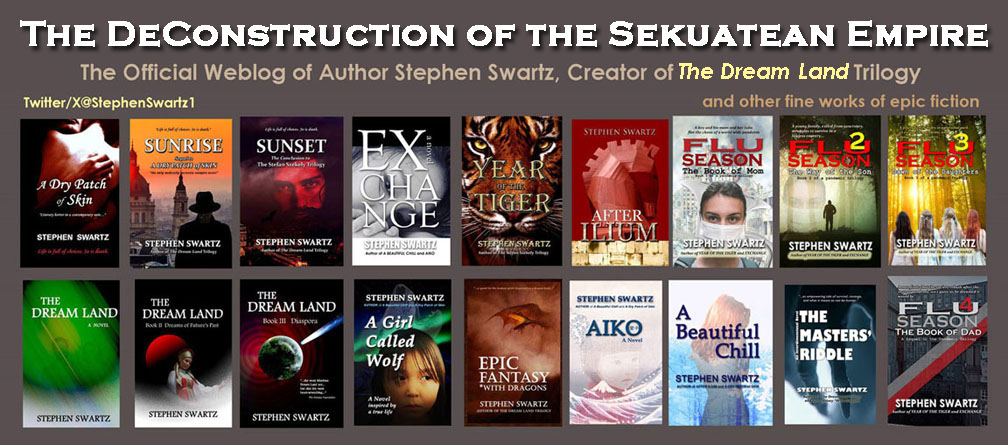They say the waiting is the worst part, and I would have to agree.
After the thrill of the first spark of ideation, the workhorse charge through a plot, the clever asides and welcome humor, the tragedy and the pathos, the love and beauty, the words of wisdom and the coming together of different paths in a satisfying unification just as our breath starts to wane . . . comes the waiting.
They say to set aside your manuscript for a couple weeks, minimum - a couple months is better - before looking at it again. Let the story settle. Forget it a little. Then you can read it again with fresh eyes and, it is hoped, you will see things that need attention - flesh out thin scenes, cut unnecessary paragraphs, add a line or two of dialog, clarify some details, re-check facts, correct typos and lapses of continuity, perhaps add a side quest to explain the sidekick's obsession with bunnies, whatever.
Meanwhile, you ring up your friend the artist and ask for cover art - or you hire a professional to design a book cover that reflects the story's genre but doesn't give away too much of the story. In my experience, book covers seldom fit exactly the story that's inside. Sometimes, it's aggravating they don't match. With fantasy, sci-fi, and horror, the image on the front cover is typically so lavish that I find myself pausing among the pages to gaze back occasionally at the image on the cover, searching there for details from the pages.
I remain amazed at the power of the image to catch us, draw us in, hold our attention, evoke our fantasies and fill our dreams . . . even as I, being the writer, labor to create with words what the artist creates with color, line and form, light and shadow, and special effects that further enrapture the viewer. It is magic. I know many writers collect pictures from magazines, the internet, or they photograph their own just to look at them while typing out a textual description of the scene. Conversely, a cover artist often works from a textual description of the design idea which the author provides.
I am now in that canyon of limbo. Everything is out of my control for a while. All I can do is wait and hope everything will work out just right. I submitted a work order for a book cover and have gotten the finished product. As far as I can tell the cover design follows my description, my idea, what I asked for. However, I find that, holding a proof copy of the book in my hands, the cover art doesn't quite "pop" as they say in the industry. I blame myself; I got what I asked for. Perhaps I should have given the artist more free reign to imagine a better design.
This experience reminds me of the power of the image over the textual. It seems unfair to me that before any reader starts to read even the first page, the reader must first be intrigued by the image on the front cover. Pick it up from the bookstore shelf. Gaze upon the picture, pondering the story represented there. Satisfied, the reader flips over the book and reads the back cover. Either there is a short description of the story, composed in such a way as to further intrigue the reader, to persuade the reader to take the book straight up to the cashier . . . or there are a few quotes from critics I don't know, whose opinions have no effect on whether I will like the book.
No matter how well written a story is, no matter how compelling the story is, no matter how well crafted the plot and its twists and denouement are, a reader will not even begin the reading experience without first being hooked by mere image. Before reading the short blurb on the back, there comes first the cover art.
Imagine deciding to go to a concert only by seeing the poster advertising the concert and reading a textual description of the music. Yes, if you know the music, you can decide based on the memory of having heard it before. Otherwise, a description of how the piece begins, what instruments play here and there, what effects the percussionists add, will not likely prompt a concertgoer to go. Would a lavish picture on the poster help persuade the concertgoer to attend separate from the words on the poster? Perhaps. It may suggest to the concertgoer that the organization cared enough about satisfying their customers to add the image. I'm only speculating, being both a reader and a concertgoer.
The book world is different. And as we move steadily forward into a world without pages, without text, it is the image which will carry civilization forward - much as mere images did in ancient times when the image of a book was the word for book. Or a scroll of papyrus or clay tablet, you know what I mean.
Ars longa, Vita brevis.
(C) Copyright 2010-2022 by Stephen M. Swartz. All Rights Reserved. No part of this blog, whether text or image, may be used without me giving you written permission, except for brief excerpts that are accompanied by a link to this entire blog.
Violators shall be written into novels as characters who are killed off. Serious violators shall be identified and dealt with according to the laws of the United States of America.






